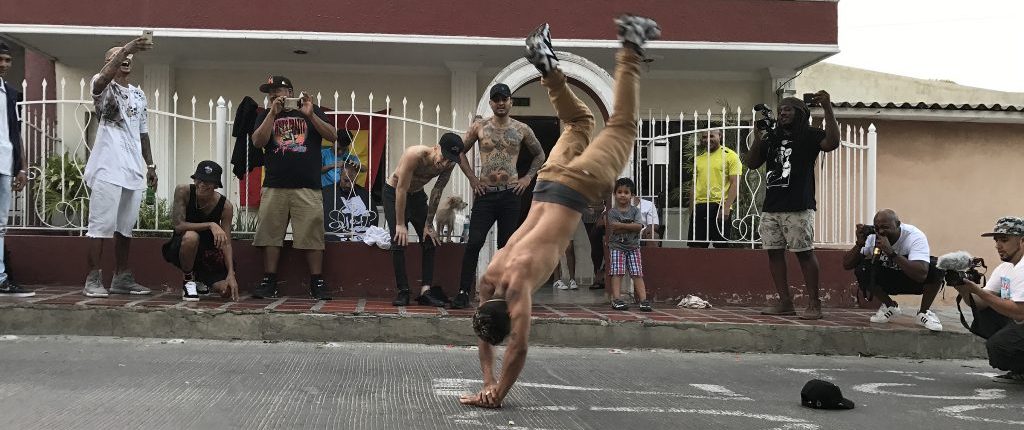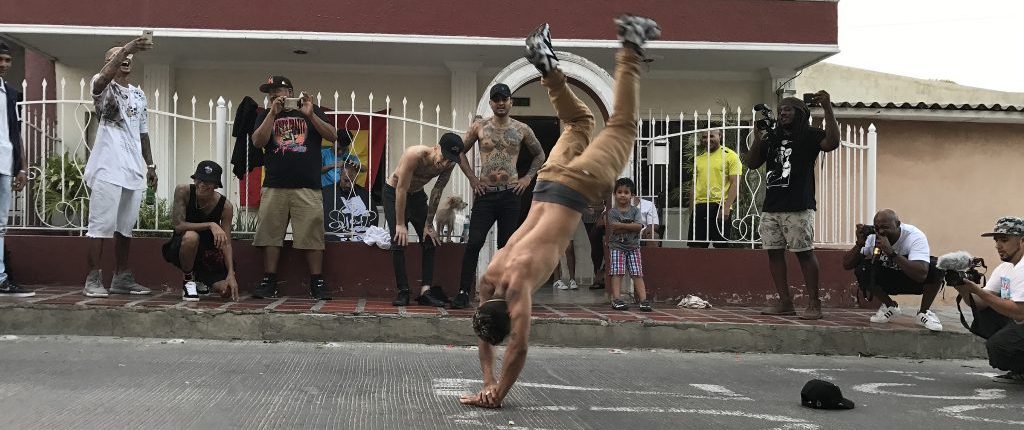When Cuban-American DJ EFN first decided to look into his roots, the result was Coming Home. That 2012 documentary followed him as he visited Cuba and explored the island’s hip hop scene. Realizing the potential that kind of intervention can have in showcasing the impact and influence of hip hop around the world, he’s since produced several more installments including Coming Home: Vietnam and Coming Home: Peru. At this year’s Miami Film Festival, Crazy Hood productions unveiled the latest doc: Coming Home: Colombia.
“It’s important for people to know that the documentaries we do aren’t documentaries about the history of hip hop in a country,” DJ EFN clarifies at one point in the film. Instead, all he and his collaborators can do is drop us into the communities making music there nowadays. Featuring hip hop artists La Etnnia, Crack Family, MC Killer, Flavor Coast b-boys, and Clika Underground among others, this docuseries episode takes audiences into the communities in Bogotá, Medellín and Barranquilla that are leading the scene in Colombia.
With plenty of drone footage as well as a visual and storytelling language that owes plenty to reality TV, Coming Home: Colombia nevertheless is a helpful primer for hip hop aficionados (as well as for DJ EFN’s fans who’ll be better able to follow along the inside jokes he and his male crew crack throughout). For those eager to learn more about the South American country’s hip hop scene, here are five things we learned while watching the hour-long doc.
Coming Home: Colombia screened as part of the 2019 Miami Film Festival
Like its predecessors, Colombian hip hop was born in the streets
Perhaps a bit too excitedly, the Coming Home crew boast that they’re visiting “real” hoods in Colombia (el Centro in Bogotá, Comuna 13 in Medellín). But that’s where hip hop thrives in Colombia, much like its origins in the Bronx. When they meet with Crack Family, “an infamous rap crew known for their come up in the streets,” we get a sense of how the genre speaks to locals. As Cejaz Negraz explains, their entrepreneurial spirit (they sell tees, caps) is also about setting an example (“try to teach these kids that they can do something else”) and moving away from a life of violence. Which is ultimately the promise and premise of hip hop.
Bogotá is a world-renowned street art mecca
To drive around Colombia’s capital, as we see DJ EFN’s crew do for much of the film, is to see street art flourishing. Graffiti, tagging, stickers; you name it, this city has it. And while the film introduces us to several graffiti writers and street artists, it also tells us the story of “Tripido,” a young kid who was shot by the police when caught in the act. The media story that followed (which was complicated by the police’s attempts to pin the kid as a thief), was made all crazier when Justin Bieber visited Bogotá a few weeks later and was escorted by the same police force while he graffitied the streets on their watch. Eventually, the city legalized street art, making concessions to the growing artistic community in Bogotá. There are now over 5,000 street artist active in Bogota with a legal license
Hip hop is changing lives
Despite starting their Medellín visit with a “Pablo Escobar” tour, the Coming Home crew decides to visit Casa Kolacho, a hip hop cultural center in Comuna 13. The once deadly neighborhood is currently being revitalized by several cultural initiatives, including this hip hop school which works on reforming kids by tapping into their creativity — through music and graffiti. It’s but one attempt to turn their history of violence into an opportunity for growth. As Jhon Farley Ciro, who works there puts it, “We learned to sell what we do without selling who we are.”
Colombia's hip hop scene proudly references the 90s
Wu Tang Clan. Tupac. Run DMC. DMX. To hear many of the MCs and rappers the Coming Home crew interview, the inspirations and influences for the hip hop scene in the South American country remain dated. But it’s because they grew from them and are now interested in moving those decades-old sounds into the 21st century with local and indigenous sounds, to speak about the current trials and tribulations of a country still afflicted by the remnants of war. “So when you hear something of ours, somewhere else,” as one says, “you realize it’s also hip hop but it’s more of our identity.”
The future of Colombian hip hop may be on the coast
While visiting the Siape neighborhood in Barranquilla, the Coming Home crew come up with a number of guys (it’s all guys throughout the doc) who talk about how central collaboration is within their community. Flavor Coast, for example, is a breakdancing group that brought various dancers together while Los Campeones Del Barrio is a hip hop collective that brings rappers together to create music and videos. That sense of collaboration may well be what sets them apart and what may make the difference in whether Colombia may create a world-class hip hop artist in the near future.




